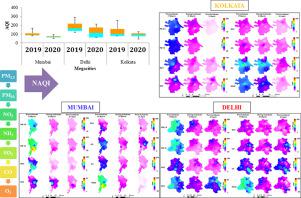Atmospheric Research ( IF 5.5 ) Pub Date : 2021-05-01 , DOI: 10.1016/j.atmosres.2021.105659 Jayatra Mandal 1 , Sourav Samanta 2 , Abhra Chanda 2 , Sandip Halder 3

|
COVID-19 pandemic compelled many countries in the world to go for a nationwide lockdown to prevent the spread of the coronavirus. India started the lockdown on 24 March 2020. We analyzed the air quality of three megacities of India, namely Mumbai, Delhi, and Kolkata, during the lockdown phase and compared it with the pre-lockdown and post-lockdown scenarios. We considered seven major air pollutants: PM2.5, PM10, NO2, NH3, SO2, CO, and O3. We analyzed the data acquired from 56 automatic air-monitoring stations (AAMS) under the Central Pollution Control Board (CPCB) spread across the megacities. The air pollution level in the eastern part of Mumbai and the western part of Delhi and Kolkata usually remains high. Delhi was the worst polluted megacity, followed by Kolkata and Mumbai. The stop of vehicular movements and industrial lockdown across the nation has substantial effects on the environment, especially in the atmosphere near the Earth's surface. Our analysis showed significant improvements in air quality during the period of lockdown (25 March to 14 April 2020) compared to the pre-lockdown phase (3 March to 23 March 2020) and the same time window of the previous year (25 March to 14 April 2019). The post-lockdown (15 April to 5 May) phase exhibited mixed results. We mapped the spatial pattern of these pollutants and the air quality index (AQI). According to CPCB, PM2.5, PM10, and CO are the major air pollutants in India that reduced by 47%, 41%, and 27% in Mumbai; 52%, 39%, and 13% in Delhi; and 49%, 37%, and 21% in Kolkata, respectively, in the lockdown phase. PM2.5, PM10, and NO2 exhibited significant correlations across the three megacities. This study shows that occasional short-term lockdowns can effectively refresh the air in these megacities.
中文翻译:

COVID-19 大流行对印度三个特大城市空气质量的影响
COVID-19 大流行迫使世界上许多国家进行全国封锁,以防止冠状病毒传播。印度于 2020 年 3 月 24 日开始实施封锁。我们分析了印度三个特大城市孟买、德里和加尔各答在封锁期间的空气质量,并将其与封锁前和封锁后的情景进行了比较。我们考虑了七种主要空气污染物:PM 2.5、PM 10、NO 2、NH 3、SO 2、CO 和 O 3. 我们分析了从遍布特大城市的中央污染控制委员会 (CPCB) 下属的 56 个自动空气监测站 (AAMS) 获取的数据。孟买东部、德里和加尔各答西部的空气污染水平通常居高不下。德里是污染最严重的特大城市,其次是加尔各答和孟买。全国范围内车辆运动的停止和工业封锁对环境产生了重大影响,尤其是在地球表面附近的大气中。我们的分析显示,与封锁前阶段(2020 年 3 月 3 日至 23 日)和去年同期(3 月 25 日至 14 日)相比,封锁期间(2020 年 3 月 25 日至 4 月 14 日)空气质量有显着改善2019 年 4 月)。封锁后(4 月 15 日至 5 月 5 日)阶段的结果喜忧参半。我们绘制了这些污染物的空间格局和空气质量指数 (AQI)。根据 CPCB,PM2.5、PM 10和CO是印度主要的空气污染物,在孟买分别减少了47%、41%和27%;德里分别为 52%、39% 和 13%;在封锁阶段,加尔各答的这一比例分别为 49%、37% 和 21%。PM 2.5、PM 10和 NO 2在三个特大城市之间表现出显着的相关性。这项研究表明,偶尔的短期封锁可以有效地清新这些特大城市的空气。


























 京公网安备 11010802027423号
京公网安备 11010802027423号